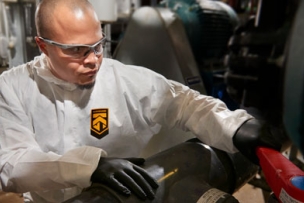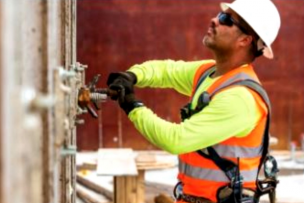Colder weather doesn’t just mean potentially uncomfortable working temperatures for your employees––it could mean an uptick in disability claims, or much worse, injuries and fatalities.
Winter is coming.
In manufacturing, colder weather means a higher likelihood for trips, slips, falls and seasonal-related illnesses such as flu and cold stress. Businesses lost an average $8.4 billion a year (not including medical costs) as a result of influenza, per a 2015 study from SmartAsset.
Winter-related slips and falls account for one-third of all workers’ compensation claims that result in lost time from work, according to a study by the Accident Fund Insurance Company of America and United Heartland. And it’s not just an uptick in claims that should be cause for concern with safety managers — the danger is deadly, too.
“Winter-related slips and falls have a significant negative impact on American businesses each year, resulting in time off work, temporary employee costs, overtime for existing employees and increased insurance costs,” explains Mike Britt, president of the Accident Fund Insurance Company of America, in the study. “To avoid these costs this winter, employers need to be extra vigilant and employees should exercise extreme caution in the months ahead.”x`
According to the CDC’s analysis of data from the from Bureau of Labor Statistics, 261,930 private industry and state and local government workers missed work from injuries due to falls, and 798 workers died in 2014. [ANCHOR 2] With lives (and the bottom line) on the line, one might assume there’s a clearly mapped safety plan all manufacturers are expected to follow for winter weather preparedness — but that’s not entirely the case.
Although ANSI does have a standard for cold protection (ANSI/ISEA 201-2012), OSHA does not. The governing body says that employers essentially must provide a workspace free from hazards likely to cause death or serious physical harm. OSHA does, however, list “cold stress” (hypothermia, frostbite, trench foot) at the top of its list of winter work dangers. Despite the fact that OSHA doesn’t enforce clear-cut rules in regard to cold and winter protection, that doesn’t mean safety managers can turn a blind eye. Here are some key ways you can prepare your people, and facility, for the upcoming winter months.
How to Prepare Your Facility and Workers For Winter SafetyYou’ll need to take into account two major initiatives: preparing your people, and preparing your facility. Ensuring your staff is equipped to handle the winter weather can further be separated into two parts: flu season preparation and on-site training.
The CDC recommends these best practices when it comes to reducing exposure to winter-related illnesses for your associates:
- Promote flu shots for employees
- Encourage proper hand-washing and respiratory hygiene practices
- Educate workers on the symptoms of the flu
- Have a flu vaccination clinic at place of business
“Vaccination has been shown to be the best way to both protect workers and their families,” explains Glenn Taylor, assistant regional administrator for compliance assistance programs for OSHA region 7. “Even if workers themselves do not get sick, those with a household full of sick people are going to have increased absenteeism from the workplace.”
Cold and flu illnesses are only the start, however. As OSHA explains, employers should train workers on ways to prevent—and pinpoint—signs of cold stress and cold stress-related injuries. At minimum, OSHA explains, associates should be trained on how to recognize symptoms of cold stress, how to monitor for symptoms in co-workers, proper first-aid selection and how to call for help, in addition to how to select proper clothing for wintry conditions.
What Are the Symptoms of Cold Stress?
Similar to physical stress high temperatures can have on the body (commonly referred to as “heat stress” that includes dehydration and fatigue), cold stress is a real safety issue in winter. What is cold stress? OSHA describes it this way:
“Cold stress occurs by driving down the skin temperature, and eventually the internal body temperature. When the body is unable to warm itself, serious cold-related illnesses and injuries may occur, and permanent tissue damage and death may result.”
“Winter-related slips and falls have a significant negative impact on American businesses each year, resulting in time off work, temporary employee costs, overtime for existing employees and increased insurance costs. To avoid these costs this winter, employers need to be extra vigilant and employees should exercise extreme caution in the months ahead.”
Trench Foot, Hypothermia and Frostbite
There are three main areas OSHA depicts: trench foot, hypothermia and frostbite. Trench foot can occur when feet have prolonged exposure to wet and cold conditions and has been known to occur in conditions up to 60 degrees Fahrenheit—so it’s not only isolated to winter-specific weather. The symptoms of trench foot, per OSHA, are: “reddening skin, tingling, pain, swelling, leg cramps, numbness and blisters.”
Frostbite is when the skin and tissues freeze and can cause damage to the body permanently—and can lead to the need for amputation in severe cases. When dressed improperly and blood circulation is reduced, the risk of having frostbite increases. The symptoms of frostbite, per OSHA, are: “Reddened skin develops gray/white patches in the fingers, toes, nose, or ear lobes, tingling, aching, a loss of feeling, firm/hard and blisters may occur in the affected areas.”
Hypothermia happens when body temperature drops below 95 degrees Fahrenheit. Prolonged work in cold conditions causes the body to use up its stored energy. In general, hypothermia occurs from extremely cold weather exposure, but it has been known to affect individuals in cool temperatures above 40 degrees Fahrenheit when the body is wet or has been sweating (or immersed in water), according to OSHA.
Mild symptoms of hypothermia include uncontrollable shivering (which helps warm the body, but “should not be ignored,” OSHA points out) and “loss of coordination, confusion, slurred speech, heart rate/breathing slow, unconsciousness and possibly death.” It is the confusion this condition causes in the brain that is very dangerous, warns OSHA, as it’s hard to recognize for the afflicted individual and may be hard to do anything about.
Alternatively, FEMA suggests spearheading a groupwide safety discussion among your workers. The “talk” should include winter weather preparedness goals, including knowing the National Weather Service projections far ahead of time and pinpointing who, and how, advisories, watches and warnings will be monitored by staff. A talk should also outline your organization’s communication and policy plans in the event of an emergency.
How to Pick the Right Cold Weather Work Gear
OSHA specifies that employers must provide proper personal protective equipment for fall protection, but not necessarily in regard to clothing used solely for protection against the elements (i.e., winter coats, jackets, gloves, parkas, boots, hats, raincoats). Regardless, OSHA says, employers should be providing their associates with this gear and proper outerwear, even if employers aren’t being forced to.
The governing body suggests wearing at least three layers of loose-fitting clothing for protection, including an inner layer of wool, silk or synthetic, a middle layer of wool or synthetic and an outer layer protecting against wind or rain. The clothing should be loose to boost circulation, and insulated gloves and hats should be worn for additional protection as well.
Optimize Your Facility for Winter Safety
Slips, trips and falls account for a particularly high number of fatalities each year. In 2015, injuries from workplace falls reached a six-year high—many of those caused by winter ice and snow creating more hazardous conditions.
When it comes to arming your facility for the winter months, preparation is key, advises Corey Berghoefer, a senior vice president of risk management and insurance at Randstad USA, in an article for EHS Today. Berghoefer recommends plotting a plan that specifically addresses employee safety and the ways in which slips, trips and falls can be prevented. First and foremost, locations where these events might be most prevalent should be identified. These would include spots with previous incident records, too. Safety managers should heavily inspect these locations and consider how changing environmental conditions might affect how well an individual can traverse the area safely.
In addition to regular housekeeping and maintenance (removing hazards, keeping walkways and staircases clean, limiting carrying heavy loads in hazardous areas), safety managers should encourage workers to come forward if they fall or see a co-worker falling. Employees designated to work in these areas should also be supplied with the proper PPE equipment, depending on the specific ailments at hand.
Lastly, Berghoefer points out, signs, cones and barricades are key in helping to avoid falls. Workers themselves should also be made visible when working in the dark and in snowy and rainy conditions.
Check out MSC's Safety Guide Book to explore more cold weather solutions.
What is your shop doing to prepare for the winter months? We want to know.





Talk to Us!
Dear Sir,
Looking for cold room shoes and gloves -30c (negative 30degree).
SHOE: Water resistant,cold insulated Slip resistant safety shoe with composite toe cap,composite midsole and heat resistant outsole -30C.
Freezer gloves -30C:
Coating:PVC
protection: Protection against cold,food.
GRIP/AREA OF USE:wet and dry grip.
PLUS: recommended for work environment with temperature up to -30C,even in the presence of bad weather and prolonged use.
Excallent for works at low temperature.
Kindly advise.
Thank you
Sunil Moneeram
All Fabrics Ltd
144What’s often overlooked in commercial refrigeration repair is the impact on energy bills. Malfunctioning components force the unit to work harder, which spikes utility costs. Timely repairs help avoid waste and keep operations running efficiently
2Leave a reply
Your email address will not be published. Required fields are marked *